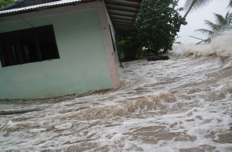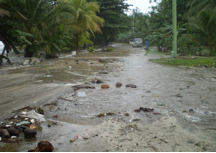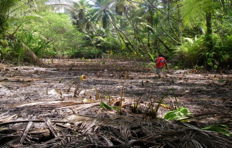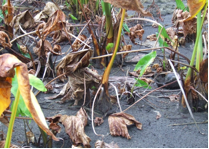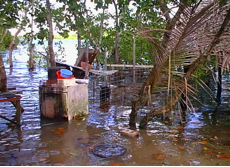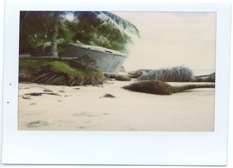The Office of E.E.M., FSM. On Sea-level Rise
/By: Universe Yamase
Edited by: Otis Aisek
Photos provided by: EEM
(December 2011)
The following interview was conducted by Universe Yamase with Cindy Ehmes of the Office of Environment and Emergency Management in FSM. The office is responsible for assessing environmental concerns within the region and to, "prevent, prepare for and recover from natural and human induced disasters".
The discussion is on the many portents of climate change within the region, namely sea-level rise. The outerislands of FSM have seen the face of this impending disaster and we try to see what our government has been doing to address this problem.
Universe Yamase = TFB
The Office of Environment and Emergency Management, Cindy Ehmes = EEM
TFB: What year was the Office of Environment and Emergency Management established? If it's a new agency, what took so long for the national government to create an office? Why is it important for FSM to have this agency?
EEM: The Office of EEM was established in May 2007 under the current President Manny Mori. It is a new office, but the two divisions that make up the office are not new divisions – Environment and Sustainable Unit used to be unit under the Department of Resources and Development and Division of National Emergency Management under the President’s office. These two offices merged in 2007 when President Mori was elected. According to President’s inaugural speech in 2007, as highlighted in the link below http://www.fsmpio.fm/Speeches/mori/inauguration.htm) – you can go on this website and see his and Vice President’s statements reflecting this administration’s strong focus on environment protection/climate change.
TFB: Is there a website or a place where the public can get information on what is happening with sea level rise? If not, why? Is it because of lack of funding?
EEM: There is a website that we are supposed to be uploading information to that is with the College of Micronesia – however, we have yet to see the college upload information that were provided by National and State governments. Because this site is to be hosted by the College, probably priorities of college staff on uploading information could be one that slows the operation of the site or perhaps the designated state nodes are not contributing to the site. The Office of EEM does not have a website on sea level rise information due to lack of funds and staff to operate such a site.
(These are some impacts below – on infrastructure, food security, shorelines, etc.)
TFB:
So far, what has the EEM accomplished in response to sea level rise? Is there an actual plan of action and evacuation for the general public?
EEM: There has been no plan of action in terms of relocating those who are affected by sea level rise. There are still people who would prefer to stay on their islands and therefore temporary relocation is usually the case, however, these affected communities still go back to their islands. Climate Change is a big issue that we small islands are faced with. EEMs response to the matter is through awareness and by addressing the two main components to climate change and the rising sea - doing mitigation actions and trying to adapt to the already changing climate.
Mitigation: reduce GHGAdaptation: address impactsLast March 2010, the EEM with the assistance of State Government counterparts undertook a vulnerability and adaptation assessment (V&A) in the outer-islands of Pohnpei, Chuuk and Yap, where they focused on some key sectors (agriculture, marine, terrestrial, coastal, water, infrastructure). The report is yet to be completed, but this will enhance FSM’s effort to leverage funds to address climate change impacts in the outer-island and its coastal communities.
There was a project completed in the FSM funded by ADB that looked at risk based approach to adaptation. The outcome of this project can be obtained at www.adb.org/documents/Reports/Climate-Proofing/climate-proofing-summary.pdf
State of Kosrae is using this model to pilot their road project currently funded by the GEF/UNDP Pacific Adaptation to Climate Change. This is a classic example of infrastructure development to address the rising sea levels.
There are other small initiatives in the outer-islands and coastal communities where funds are being allocated to address food security and coastal restoration.
TFB: Does EEM have inundation maps? Is there a protocol in place?
SEAFRAME: Pohnpei harbor
EEM: We do have some inundation maps – not sure what you mean by protocol in place, but we do have photos when there are disasters pertaining to salt water inundation into taro patches (in the outer islands) or on infrastructure (roads, etc) on coastal communities. These maps show areas that are prone to sea level rise, though mostly covering the four main island states and not the outer-islands.
We also have data that is being recorded daily – a project funded by our development partner Australia which monitors the sea level in Pohnpei and Kosrae, although we are trying to get Chuuk and Yap hooked on these tide gauges.
TFB: What are the problems and challenges that EEM faces when dealing with sea level rise?
EEM: We are fortunate that EEM is an Environment and Emergency Management – so USAid (formerly FEMA) assists our States when Governors declares a state of emergency. As far as environment division, we lack funds to address impacts of sea level rise on food crops, infrastructure, water resources, etc., but with little funds that we can get from donors, we are able to do some restoration like provisioning of agricultural crops/seedlings to those affected islands, assist with infrastructure climate proofing – i.e. runway expansion in Pohnpei, Road construction in Kosrae, raised taro beds in Chuuk, field testing of salt tolerant crops for the outer-islands and coastal communities, coastline restoration projects through replanting endemic trees, etc. With funding, we can do so much to adapt to the rising sea.
TFB: Does EEM have the capabilities to provide necessary training & tools for sea level mitigation and resilience without foreign assistance?
EEM: Awareness has been one of our major activities – we have gone to communities and schools to raise awareness on climate change and its impacts. We cannot mitigate sea level rise, but we try to raise awareness on how atoll islands and coastal communities can adapt to the rising sea. This is a global issue that we try to push at international (united nations) forums to keep telling major emitting countries to provide resources to small islands who are most vulnerable to adapt and to lower their emissions as well. One big forum is that of the UN Framework Convention on Climate Change (UNFCCC) in which my boss Andrew is participating in at this time. FSM is a party to this UN convention and every year, parties get together to discuss issues and come to decisions on how to address impacts of climate change. You can visit www.unfccc.int for more information.
TFB: What agencies and organization from their respected countries are collaborating with EEM for better preparations and planning for the sea level rise?
EEM: Our major developed country partners are Australia, Japan and the European Union. Our developing partners are China and Venezuela so far… These countries assist with climate change activities which include sea level rise, although USA has in the past introduced the raised taro beds to address the impacts of typhoons that destroyed crops in the outer-islands of Yap. This is an adaptation measure that is successful and now some outer-islands in Yap and Chuuk are also building raised taro beds due to salt water inundation into their taro patches.
TFB: Is EEM working with other FSM departments for sea level rise planning?
EEM: EEM drafted the FSM wide climate change policy that was signed by President Mori in December 2009. I am attaching that for your information. Please note that President Mori also directed all other sectors to develop their plans/strategies and to mainstream climate change into their plans/strategies. So far, the energy policy, agriculture policy, water policy, food security policy have been developed and climate change mainstreamed – others are soon to follow. FSM’s Infrastructure Development Plan was climate proofed in 2004 – the report can be found on http://www.adaptationlearning.net/project/climate-change-adaptation-project-pacific-climap
For your information, President Mori and the four State Governors designated a group that is called the FSM climate change country team who oversees all climate change and related activities in the FSM. This country team also attends on FSM’s behalf in community, state, national, regional and international forums. They also do a lot of climate change and sea level rise awareness in schools, communities and this group makes sure that FSM being a party under the UNFCCC meets their obligations.
TFB: Is EEM far behind in Hawaii's sea level rise planning? Does EEM look into Hawaii's module of sea level rise? If not, which pacific island has the best practical module for FSM to follow?
EEM: I am not sure what you mean about sea level rise planning and modules… When we face issues of sea level rise, we try to respond with assistance of our developed country partners. We plan to develop our climate change National Implementation Plan, but that is yet to materialize due to lack of funds. FSM is currently developing its second national communication as a reporting obligation to the UNFCCC, and hopefully that can be a document that donors can begin to fund once it is submitted to the UNFCCC Secretariat. The Global Environment Facility and UNFCCC funding mechanisms are available for us in which we are currently accessing funds to address climate change impacts which also includes sea level rise.
TFB: Is FSM in a much vulnerable state to sea level rise? Why? Is it because of the islands' geographic position? Isolation? What are the reasons?
EEM: FSM and all small island states are vulnerable to sea level rise. FSM is a member of the Alliance of Small Island States (AOSIS), a group of 43 small island states that are pushing for common issues at international forums. You can visit the http://aosis.info to learn more of AOSIS and their issues.
The reasons for sea level rise?? I think you can search that online and find out the reason why there is sea level rise – the earth is warming up due to all those gases that are trapped in the earth’s atmosphere (read up on the greenhouse effect). Regardless of where we are, we are vulnerable as a small island state even though we emit very little compared to a lot of bigger countries.
TFB: Where will people go if their lands are underwater? Any solutions that EEM has come up with?
EEM: The position of the FSM now is that we can relocate our outer-island and coastal communities on higher ground (higher islands). Yap Government is already allowing their outer-islanders to move to Yap proper which is the main and high island. Relocation is within the country and not outside of FSM because if we even try to approach bigger countries on relocation, then we become environmental refugees and thereby showing the world that we basically gave up on our sovereignty over our islands and gave up our right to live as FSM citizens… we do not want to show the bigger emitters that we basically gave up our right to live on our own islands – you can look at the FSM nationwide climate change policy to better understand that we want to preserve our culture, identity, heritage, etc. That is why we try as much to participate in the international forums to voice out to the bigger emitting countries to lower their emissions so we can live and our future generations can also live in our islands.
